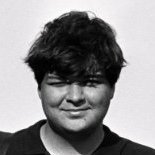
John Pytlak RIP
Premium Member-
Posts
3,497 -
Joined
-
Last visited
About John Pytlak RIP

- Birthday 07/15/1948
Profile Information
-
Occupation
Industry Rep
-
Location
Rochester, NY 14650-1922
-
Specialties
(John passed away on August 17, 2007 after a year-long battle with cancer.)
Helping Kodak customers get the best possible quality from Kodak products and services. Developed LAD, TAF, PTR film cleaners, and worked on many film development programs at Kodak. Fellow of SMPTE. Member of BKSTS. Chairman of Inter-Society Committee for the Enhancement of Cinema Presentation. In 2001, I won an Academy Technical Achievement Award for the development of the Laboratory Aim Density (LAD) control system (presented by Renee Zellweger, video available in the "Videos" section of Film-Tech: http://www.film-tech.com )
Contact Methods
-
Website URL
http://www.kodak.com/go/motion
Recent Profile Visitors
-
Hello, it's Anne again. Thank you so much for all your kind words and sharing of memories. Some have inquired about the arrangements: John offered his physical body to the University of Rochester anatomical gift program. A memorial Mass will be held at the Church of St. Jerome, 207 South Garfield Street, East Rochester, NY 14445 at noon on Saturday, August 25, 2007. In lieu of flowers, donations may be made in John's name to: The George Eastman House, 900 East Avenue, Rochester, NY 14607.
-
Hi everyone, This is Anne, John's daughter. I am so sorry to give you the news that my dad passed away last night at 11:40pm EST after a year-long battle with cancer. My dad had a fantastic day Thursday -- he felt the strongest he has in a long time and had a very enjoyable day with his sister and brother-in-law who came to visit. He has been sleeping downstairs the past few weeks in a hospital bed and I have been nearby on the couch, and he slept quite well Thursday night. Friday morning he said he felt weaker than usual, but was very optimistic about trying to have more nutrition within the next few weeks. At 10am, he started having severe cramping and it got progressively worse as time went on. He was on 2ml morphine every half hour and nothing could stop the intense pain. Even though he had so much morphine, he never lost his consciousness and was very alert throughout the whole ordeal. He decided to enter hospice that evening. My sister Katie flew home from Boston and arrived around 10:30pm. At hospice, the nurses were able to give him enough sedatives to lessen pain, and he fell into a deep sleep. He died very peacefully, surrounded by family. He gave me his username and password a few weeks ago and wanted me to inform you of the news when needed. He loved participating on film tech, cinematography.com, and various film boards and he had such admiration and respect for you. He -- and my family -- appreciated all your kind words and prayers. My dad may not have met many of you face to face but he considered you all his dear friends.
-
I am still "hanging in there". The main issue is now getting enough protein and calories into my system to sustain itself. For now, the cancer center does NOT want to use direct protein infusion into an IV "PIC Line" which has a very high risk of infection that could kill me. They prefer trying to heavily dilute my oral protein and calorie supplement so it does not cause cramping or build up excessively in my totally blocked small intestine. Without nutrition (calories), my body is getting very weak --- a few days ago, I fell from weakness, and needed someone to lift me back up again to use the walker to support myself.
-
Unfortunately, some of the thicker "clear liquid" supplements like "Enlive" have caused SEVERE painful cramping. Last evening, I was in great pain for over an hour until the thick residue drained out though my drainage tube and eventually got vomited. Remember, nothing is going through my small intestine, which is blocked by tumors, so what goes in by mouth has to come out by mouth (vomit). :(
-
I'm still hanging in there! Recovered well from the fall. Have a hospital bed and very comfortable recliner set up in our family room. Able to use a walker to get around the house, and to twice-weekly IV hydration at the cancer clinic. Unfortunately, not able to get many calories or much protein into my system, so I continue to lose weight and strength. (Have vomited several times in last week, so I am probably not getting 1000 calories and 60 grams of protein per day). Support from family and friends has been great. Your prayers and good wishes continue to cheer and help me.
-
Pre-Exposing or �Flashing � film
John Pytlak RIP replied to bobbioni's topic in Film Stocks & Processing
"Percentage" flash is sometimes used to measure the degree of flash level. In most cases, the best measure is the amount of density the flash adds to the normal minimum density (D-Min) of each imaging layer of the negative. In general, with a neutral flash, the increase is the same in each layer. An increase of +0.10 density would be a relatively low level of flash, an increase of +0.30 density is more of a contrast decrease in the shadows. Remember, the effect of the flash also depends on your basic exposure -- as you increase exposure, the scene information is placed higher on the sensitometric curve, lessening the effect of the flash exposure, which primarily is softening the "toe" of the negative. That is why it is important to work with your lab in seeing the effect of various flash levels/techniques, and running some practical picture tests to establish the flash and exposure level. -
best stocks to handle sodium vapor
John Pytlak RIP replied to F Bulgarelli's topic in Film Stocks & Processing
The AC flicker issue with a direct discharge lamp (sodium vapor, mercury vapor, neon) will be more severe than with a flourescent tube, where the phosphor's light output has some "lag" or afterglow. Of course, in a large filament tungsten lamp, there is lots of lag or afterglow between cycles, and so very minimal flicker with typical studio tungsten lighting. -
Hello to all my friends here on Cinematography.com! I've just had a "near death experience": I just spent two days in the hospital (Thursday and Friday, July 26-27) after a very scary event on Wednesday evening. Our older daughter Katie had been spending the week in Rochester from Boston with us to help out. I had purchased a new Toshiba notebook computer system (with Windows Vista Home Premium) that was delivered earlier in the week, and had unpacked it. I was getting ready for bed at about 10:00pm Wednesday, and noticed some of the empty boxes were still in the side hall. I took one small box into the garage through the swinging storm door and down two steps. No problem, although my legs are getting quite weak and wobbly from loss of body mass, especially since mid May (down to 115 pounds from a pre-cancer weight of 172 pounds). The second empty box was large and bulky, so I decided to gently pull it backward through the swinging door. The last thing I remember is pulling on the box as I backed through the door. The next is the Ambulance EMT crew strapping me to a flat board with a neck brace, and shining lights into my eyes, probably 7-10 minutes later. Katie heard the crash, and was the first to find me, flat on my back, totally unconscious on the cement floor of the garage. She says I was not breathing, and she began gentle chest compression and mouth-to-mouth resuscitation. Younger daughter Annie helped too, while my wife Betsy called 911 for the ambulance. Katie says I started breathing on my own in 30-40 seconds, and after a few minutes was groggily talking to her. The back top right side of my head was bleeding profusely from a deep ragged gash where I had hit my head during the fall backward onto the garage floor. I also had some bruising and abrasion along my back. The Ambulance EMT crew was great. Our neighbor is an EMT, got the call, and ran right down to our house. After securing and checking me out, the ambulance crew rushed me to the hospital where I have been going since my illness began last September. Betsy rode in the ambulance, and our good neighbors gave Katie and Annie a ride to the hospital. At the hospital, they cleaned the head wound. It took six stitches to close the ragged gash. They took x-rays to look for rib or back injury, and a head CT scan. The head CT scan showed some fluid buildup on the right side of the brain, and there was a bit of weakness and tingling in my left foot. They prescribed a strong cortisone type drug to help reduce the brain swelling, and I spent the next two days in the hospital to heal, build my strength, and recoup a bit. Katie's husband Jim and our grandson Ben drove in from Boston, and visited me in the hospital to cheer me, along with the constant daytime presence of Betsy, Katie and Annie in shifts. Before being released, I had some PT to be sure I could walk with the help of a walker, and even climb stairs with rails. Even though I can walk and climb stairs slowly, my muscle weakness and the weaker left side (I drag my left foot a bit) require that someone walk with me to steady me and be sure I don't fall down again. I came home from the hospital late Friday afternoon (July 27). Saturday, a visiting home nurse checked my vital signs and redressed the head wound. Then a physical therapist gave me a home evaluation of my capabilities with a walker and stairs, and agreed that until I am more steady on my feet, I need someone to walk with me. It looks like I will still be able to travel to the local cancer clinic for my regular IV hydration on Tuesdays and Fridays. Everyone agrees that I not try to do too much on my own, especially never stairs into the garage or basement, lest I take another bad fall. My sister and her husband visited Saturday, while the nurse and PT were here, and then spent most of the afternoon. It was an enjoyable visit, making Saturday a very full day. Katie, Jim and Ben drove back to Boston Saturday evening, as Jim has to work at his high school's summer retreat starting Sunday evening and for the week, and Katie is working half time at her campus ministry job at Boston College. I am getting back on a normal schedule. I am able to have a "clear liquid" diet, which includes water, fruit juice, Jello, broth, and other clear liquids without bulk. Unfortunately, the complete intestinal blockage precludes more calorie-rich liquids like Boost or Ensure or soups. So at most, I am getting only about 500 calories per day, and likely to continue losing weight and strength. Fortunately, last week after several days of severe vomiting, I was prescribed Protonix to stop stomach acid, and it has somehow also helped greatly reduce the vomiting that I had been having to throw up digestive juices. So I am able to hold down these clear liquids and my medicines. For now, I am sleeping downstairs, in a fully adjustable hospital bed set up in our family room, right next to a comfortable recliner, both facing my new HD television -- a pretty cozy setup. :-) (But I still miss getting to see movies on a big theatre screen). Annie has been comuting each evening from her job in Buffalo, and plans to sleep downstairs if I need any help during the night. I also spend time at the computer. Jim was able to set up my new notebook computer, and transfer most of the files and set it up on a wireless home network, and my plans are to complete the transfers from my old (Windows ME) system during the next week. In five years, I've accumulated over 5000 Kodak digital photos, that are now backed up to a separate USB hard drive, and tranferred to the new computer. I've always been a "pack rat" like my Dad (my basement is still filled with hundreds of boxes and files), and my computer files are no exception. Well, as you can see, I've had quite a week! Katie jokes that she intends to write a book about her father's "nine lives" of experience since last September. In reality, everyone's prayers and good wishes have seen me through alot, and cheered me along the way this past year. I've gotten to see and play with my wonderful first grandchild Ben many times, I've just celebrated my 59th birthday, I still am able to help my friends on the Internet Support Groups, and now I've survived a near death experience (no, I didn't "see the light"). I'm ready for death, but life is certainly still worth living. Like the Engergizer Bunny, I keep on going. Please keep those prayers and good wishes coming. Miracles don't always result in a "cure", but in lots of daily blessings to help though a severe illness.
-
Look at the sensitometric curve published by Kodak. As long as scene content is not falling on the flat "D-Max" of the curve, the film is still recording highlight "detail". And 7218 has a very long straight line portion, and gentle shoulder roll off, that can capture highlights that are overexposed by 4, 5, or more stops. Of course, the negative is becoming very dense, and will need extra light to print or transfer through the added density.
-
Fuji Reala 500D 8692
John Pytlak RIP replied to John Carson McCarthy's topic in Film Stocks & Processing
You may find the unique spectral characteristics of the Fuji Reala change the color reproduction of certain floral, foliage, and flesh colors. Dusk/dark is best handled by appropriate filtration, as it is not usually a true mixed lighting situation. -
Kodak 5217 under X-Ray.
John Pytlak RIP replied to Matthew Buick's topic in Film Stocks & Processing
Yes, X-ray inspection always has the potential to fog the film, which can show up as a loss of contrast and color, and uneven blotches or streaks depending on the type and extent of exposure. Faster/older films are more prone to fogging. NEVER put unprocessed film in CHECKED baggage, as the x-ray scanners used are very powerful, and concentrate their beams. For carry-on baggage, the x-ray intensity is usually less intense and more diffuse, but there is still a risk of fog buildup, especially if the security operator decides to take several different "views" of the suspicious package, or you go through multilple inspections. Lead bags offer little protection, as the operator will just take more views or turn up the power to see through the lead bag. Given time and politeness, most security people will be willing to do a hand inspection, but you will need to provide a changing bag and a few test carts so they will know what they are feeling for in the changing bag. The USA TSA regulations specifically allow passengers to request hand inspection for any MOTION PICTURE film, regardless of speed. http://www.tsa.gov/travelers/airtravel/ass...orial_1035.shtm -
Anton Corbijn / Control - Which Stock?
John Pytlak RIP replied to grant mcphee's topic in Film Stocks & Processing
Sure, printing and processing the reels in the same ''batch" will reduce variability. -
Anton Corbijn / Control - Which Stock?
John Pytlak RIP replied to grant mcphee's topic in Film Stocks & Processing
A black-and-white image printed onto color print stock is very critical for color balance. The slightest difference in printer balance or processing will give a slight color change between reels. Much more noticeable than with a color image.





.thumb.jpg.3ed15ccc2ff3863640108abfc8641e45.jpg)
